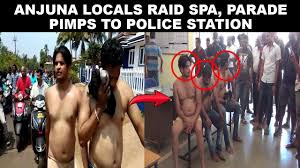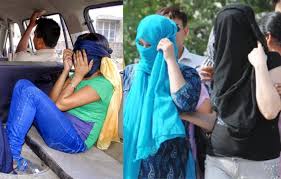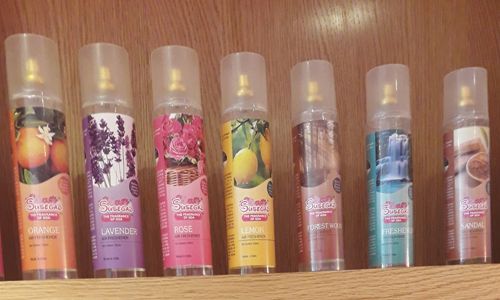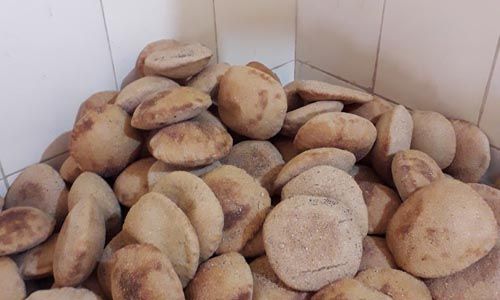The fact that the prostitution racket has burgeoned in Goa is indicated by people’s anger and villagers becoming vigilantes because authorities refuse to act as they are paid off. Goa is not only a destination state, almost 12 per cent of Goan woman too have been victims of CSA. And it has also spread to the interiors. Goa's image projected by the government and tourism industry as a place where booze, drugs and girls are available, has led to the proliferation of CSA here.
November 8, 2019
Pushpa Iyengar
The fact that the prostitution racket has burgeoned(see pic of protest march) in Goa is indicated by people’s anger everywhere in this state which first attracted tourists to enjoy the sun, beaches, the green paddy fields and the simplicity about life mistakenly referred pejoratively as “sussegado”.
In May this year, fed up with authorities refusing to act against their regular complaint for a year that the SA2 spa (that’s usually a euphemism for commercial sexual activities –CSA-) and wellness centre in Anjuna where prostitution was proliferating, the villagers became vigilantes, beat up the staff and handed them over to the police. In fact, the Anjuna-Caisua panchayat had issued a licence to a Shakir Hussain to run a 'spa and wellness centre'. Police arrested five persons, including the owner, and rescued two women.
 Why a spa would have bouncers is a million dollar question (see accompanying pic). The local panch Hanuman Govekar admitted that male tourists were lured but once they entered the centre, the staff/bouncers extorted money and even beat them up if they refused to pay.
Why a spa would have bouncers is a million dollar question (see accompanying pic). The local panch Hanuman Govekar admitted that male tourists were lured but once they entered the centre, the staff/bouncers extorted money and even beat them up if they refused to pay.
That the panchayat and police was looking the other way because they were being paid off is evident. Now Anjuna Sarpanch Savio Almeida claims, “We will revoke the permission issued to the wellness centre.” But those are platitudes that have been trotted out to cool tempers and have always been and that’s why CSA has proliferated in Goa.
A sleazy movie
An example is this incident. A15-year-old girl strikes up a friendship with 19-year-old Shilpa Rathod, after a 'chance' meeting on the bus on her way back from school. The friendship grows and the teenager invites Shilpa to her home and village.
Shilpa plays along giving off BFF vibes and moves in for the entrapment. She invites the teenager to her house where she lives with her mother, Laxmi, 38, and older sister and plies her with food and beer. The second time the survivor was given enough beer to make her intoxicated. “She remembers some men entering the flat and forcing themselves on her. The next morning Shilpa threatened her to keep quiet and gave her some money (Rs 1500- 2000 each time),” says the police who arrested Shilpa, Laxmi and Ismail Shaikh, the autorickshaw driver who used to source customers, last month.
There were many times over the next six months the same scenario played out. It's when the teenager began to have health problems and began to absent herself from school, it was noticed. After she began to walk strangely, her parents were called in but they claimed that she had developed a rash but were reluctant to take her to a doctor. The whole murky affair came to light when the institution called in a counselor.
But in an indication that once in the flesh trade, it is not easy to escape its clutches, the teenager was stalked by unindentified men when she went AWOL for 15 days.
Brand Goa has deteriorated
Goa thus is not only a destination state for flesh trade; Goan woman too have been victims of CSA. Almost 12 per cent are Goan girls involved. And it has also spread to the interiors of Goa. Two days ago, a “high profile call girl racket” at Bicholim where college girls are reportedly involved was alleged.
While CSA dominates the coastal belt of North Goa, with maximum police rescues are in Calangute Police station jurisdiction, followed by Anjuna police station jurisdiction. But it has spread to Bicholim, Verna, Vasco, Margao, Ponda, which are not tourist hubs.
The image of Goa projected by the government and the tourism industry as a destination where booze, drugs and girls are freely available, has contributed hugely to the proliferation of CSA here.
Goa is one of the major destinations in India for trafficking of women and was the focus of the study by Arz (Anyay Rahit Zindagi) on ‘Trafficking of Women & Children for Commercial Sexual Exploitation (CSE) in Goa - Statistical Analysis (2014 to 2019)’, based on interviews of 400 girls and women rescued between June 2014 to May 2019. The girls trafficked here were from 24 states in India, including Goa. Girls were trafficked too from neighboring Nepal & Bangladesh, Uzbekistan, Kyrgyzstan, Turkmenistan, Turkey, Russia and Thailand.
The profile of the victims
The girls trafficked to Goa were mostly those exploited for a long time elsewhere before being sent here. Girls trafficked from Central Asia are first commercially exploited in Delhi and then sent to Goa, whereas, girls from Bangladesh are first trafficked to Maharashtra and then to Goa, the study found. It added that once the victim has accepted CSA as "no other choice”, or is under the “control of the trafficker” she is trafficked to Goa.
 The pimp was confident they would not approach the police or reveal details about the traffickers. Girls get bad publicity, but pimps disappear. (see pic) Ironically, Goa’s image as a safe place for women worked against them because parental permission to visit here to “enjoy with friends” was a breeze. Some told parents they were attending events, catering and/or taking part in dancing assignments and got the green signal.
The pimp was confident they would not approach the police or reveal details about the traffickers. Girls get bad publicity, but pimps disappear. (see pic) Ironically, Goa’s image as a safe place for women worked against them because parental permission to visit here to “enjoy with friends” was a breeze. Some told parents they were attending events, catering and/or taking part in dancing assignments and got the green signal.
In fact, peer involvement has been an important factor in the trafficking of girls to Goa. Also pimps have employed girls who work in events to lure other girls, while in some cases, it was a friend who lured them under the guise of giving them a job or for an event in Goa.
Some years ago, there was a young girl in the check-in queue at the airport looking uncertain and nervous but at the same time, a tad defiant, eliciting a rude comment from a passenger like she was wearing a scarlet letter. An indication that it’s well known that CSA victims routinely fly in and out of Goa. In fact, many girls are lured into the trade here by the flight tickets dangled by the trafficker because for them flying has always been an illusion. And part of the package deal is hotel rooms. But, once in Goa they are blackmailed saying if they refuse CSA, they will have to return the money for the flight tickets.
Why Goa?
A majority of the girls felt that the conditions for CSA including food, stay, money, clients and transportation were better in Goa compared to other parts of India, the study found. But on the other hand, they get outed sooner here because of long drawn out procedures after they are rescued.
“The pimps/agents made fake Aadhar cards, voting/ pan card, Nikah Nama and driving licence for foreign nationals which are used as identity proof for travelling, checking into hotels, opening bank accounts, purchasing sim cards, etc.
The women are trafficked to Goa on a contract of 10 days to 1 month after which they are sent back. The traffickers regularly rotate the women that are sent to Goa. “The victim is usually paid 10% to 25 % of the money received from the clients. The remuneration is fixed for the contract period with the condition that she will entertain a fixed number of clients per day. In case the clients are below that number, the clients serviced by her on that day are not counted and she loses money for the day,” the study said.
It is estimated that at least 1000 women and young girls are trafficked into Goa, but only about 100 are rescued every year.
(Concluded)



